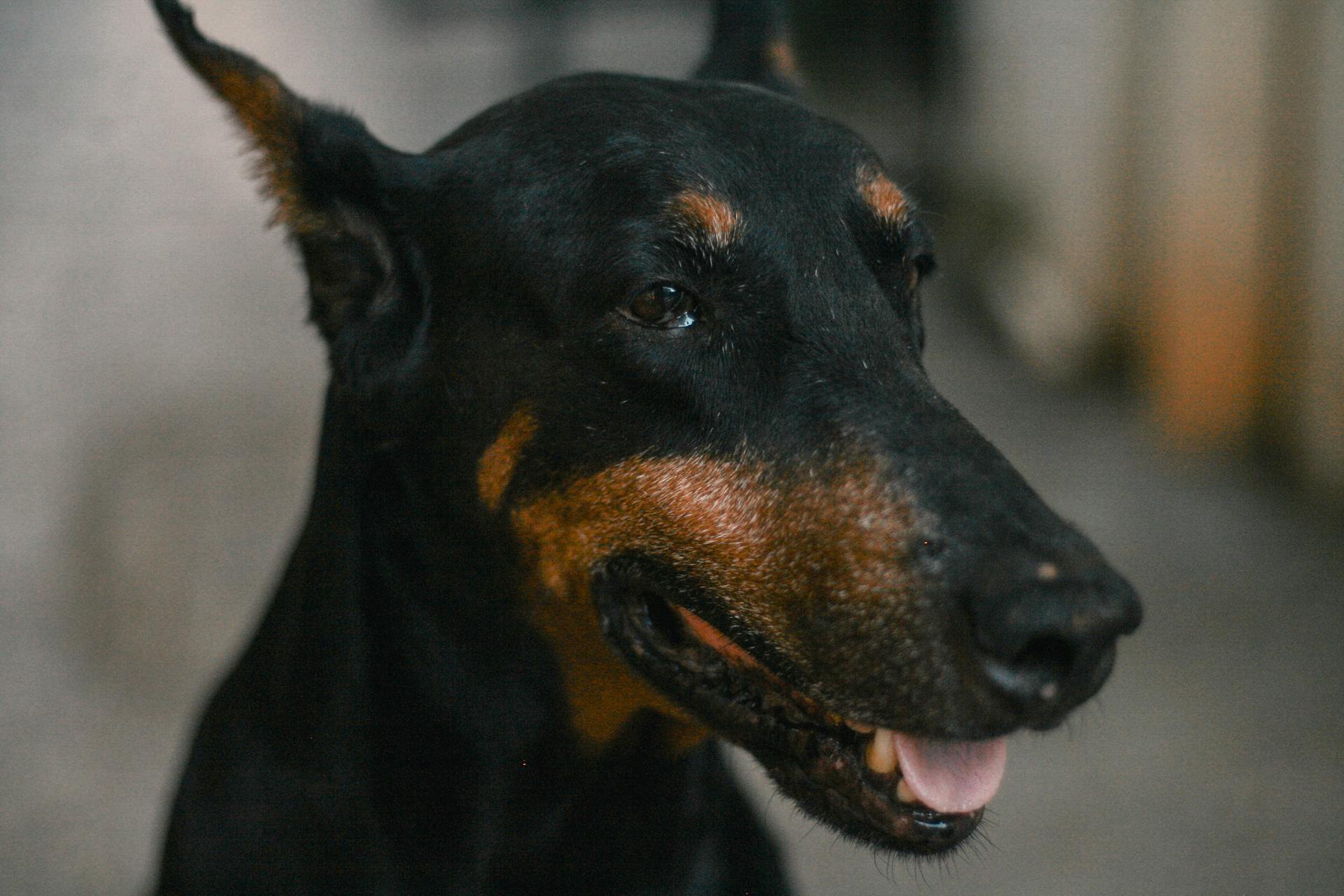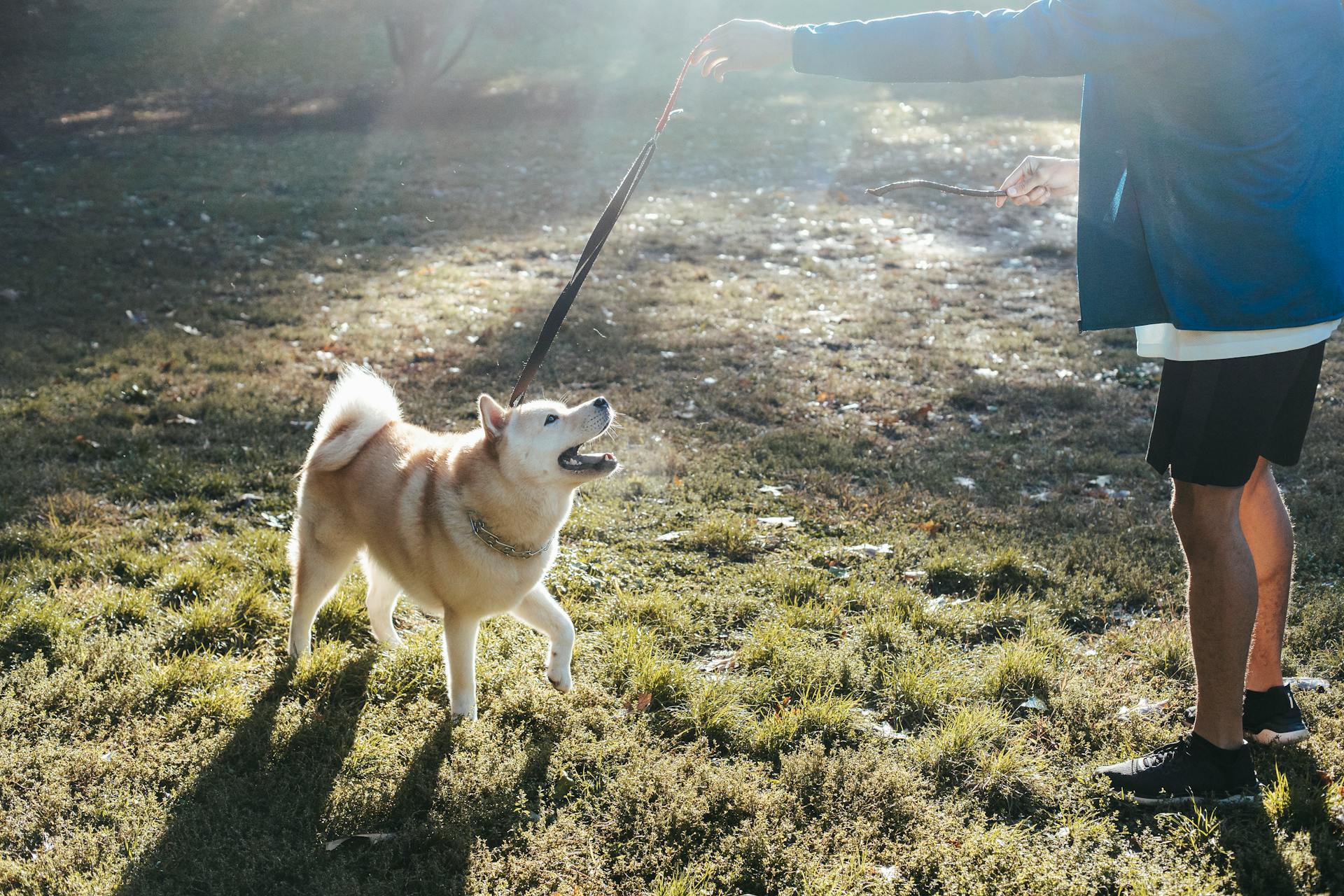
Doberman Pinschers are known for their sleek, athletic build and short coats, but they can be prone to certain skin conditions that require attention.
One common issue is seborrhea, a skin condition that causes flaking, oily skin and can be triggered by allergies or genetics.
Some Doberman Pinschers may experience hot spots, which are painful, inflamed skin lesions that can be caused by allergies, fleas, or skin infections.
Regular grooming and veterinary check-ups can help identify and address these issues early on.
Common Skin Issues
Doberman Pinschers are prone to various skin issues, and it's essential to be aware of the common problems they may face. Malassezia dermatitis, caused by yeast, can lead to greasy, hairless areas on the neck and throat, accompanied by a characteristic odor.
Demodex mites are microscopic parasites that live in the hair follicles of dogs, and while all dogs have them, some breeds, like Doberman Pinschers, can develop an overabundance, leading to dry, irritated, hairless lesions on the face or feet.
Pemphigus foliaceus is a superficial skin disease more common in Doberman Pinschers, causing crusts and hair loss, usually on top of the nose and inside the ear flap, which can worsen with sunlight.
Mange (Mites)
Mange is a skin disorder caused by tiny parasites called mites, and it's a common issue in dogs. Sarcoptic mange, also known as canine scabies, spreads easily among dogs and can also be transmitted to people, but the parasites don't survive on humans.
The symptoms of mange are intense itching, red skin, sores, and hair loss, with a dog's ears, face, and legs being the most commonly affected areas. Demodectic mange, on the other hand, can cause bald spots, scabbing, and sores, but it's not contagious between animals or people. Treatment depends on the type of mange.
Demodex is a microscopic mite that lives in the hair follicles of dogs, and all dogs have them. Normally, a dog's immune system keeps the mites in check, but some breeds, like Doberman Pinschers, develop an overabundance of these mites.
Color or Texture Changes
Changes in a dog's skin color or coat texture can be a warning sign of several common metabolic or hormone problems.
A simple blood test is usually all it takes to identify the underlying cause of these changes.
Noticeable changes to your dog's coat can also result from an infection or other skin disorder.
It's essential to ask your veterinarian about any significant changes to your dog's coat.
A simple blood test can identify the underlying cause of many skin issues, making it a crucial diagnostic tool.
Readers also liked: Canine Brucellosis Test
Multiple Skin Problems
Your Doberman is susceptible to different kinds of skin infections and diseases, including yeast (Malassezia dermatitis) and seborrhea.
Malassezia dermatitis can cause itching, redness, and a brown waxy discharge in the ears, as well as greasy, hairless areas on the neck and throat with a characteristic odor.
Seborrhea can cause dry, flaky skin or greasy, oily skin, making your pet itchy and uncomfortable.
Bathing with special shampoos and rinses may be helpful in treating these conditions, and treating any underlying problems such as allergies is also crucial.
Demodex is a microscopic mite that lives in the hair follicles of dogs, and all dogs have them, but some breeds, like Dobermans, can develop an overabundance of these mites.
In mild cases, you may notice a few dry, irritated, hairless lesions on the face or feet, which may or may not be itchy.
Secondary skin infections can occur, and prompt veterinary care is important to keep the disease from getting out of hand.
Many pets seem to outgrow the problem, while others require lifelong management.
Skin Conditions Caused by Health Issues
Your Doberman Pinscher is prone to various skin conditions, but some of them can be caused by underlying health issues.
Malassezia dermatitis, a common skin disease, can be triggered by allergies.
Demodex mites, which live in the hair follicles of dogs, can cause skin lesions and infections.
Pemphigus foliaceus, a superficial skin disease, can be exacerbated by sunlight.
Lupus, an autoimmune disorder, can cause skin abnormalities and kidney problems in dogs.
If you notice any skin lesions or infections that won't heal, it's essential to bring your dog to the vet promptly.
Early diagnosis and treatment are crucial in managing these conditions and preventing them from getting out of hand.
Allergies and Sensitivities
Allergies can be a major skin issue for Dobermans, manifesting as itching, redness, rashes, and recurrent ear infections.
Dobermans can develop allergies to various environmental factors, such as pollen, dust mites, or certain foods.
Managing allergies may involve identifying and avoiding allergens whenever possible, and in some cases, antihistamines or corticosteroids may be prescribed to reduce allergic reactions and control itching.
Allergic reactions can cause itchy rashes, and corticosteroids or other medicines can help alleviate the discomfort.
Identifying and avoiding exposure to allergens is often the most effective treatment for allergic dermatitis.
For your interest: Are Goldendoodles Allergic to Chicken
Allergies and Sensitivities
Allergies and sensitivities can cause a range of skin problems, including hot spots, which are small areas that appear red, irritated, and inflamed.
Hot spots can result from a wide range of conditions, including infections, allergies, insect bites, or excessive licking and chewing.
In some cases, allergies and sensitivities can lead to acral lick dermatitis, also known as acral lick granuloma, where a dog excessively licks, bites, or chews a specific area, leading to hair loss, inflammation, and open sores.
See what others are reading: Great Pyrenees Hot Spots

Treating acral lick dermatitis requires breaking the cycle of self-trauma, which can be achieved by identifying and addressing triggers, such as stress or boredom.
Addressing the underlying cause is crucial in treating acral lick dermatitis, and this may involve behavior modification techniques, bandaging or covering the affected area, bitter-tasting topical applications, anti-inflammatory medications, and addressing any underlying pain or discomfort.
In addition to treating the symptoms, it's essential to identify and address the underlying allergies or sensitivities that may be causing the skin problems.
Intriguing read: Why Do Yorkshire Terriers Lick so Much
Folliculitis
Folliculitis is an infection that causes sores, bumps, and scabs on the skin. It's often easier to spot in shorthaired dogs, but in longhaired dogs, it can manifest as a dull coat and shedding with scaly skin underneath.
In some cases, folliculitis occurs alongside other skin problems, such as mange or allergies. Treatment may involve oral antibiotics and antibacterial ointments or shampoos to clear up the infection.
For more insights, see: Difference between Kennel Cough and Upper Respiratory Infection
Allergies

Dobermans can develop allergies to various environmental factors, such as pollen, dust mites, or certain foods. Allergies often manifest as itching, redness, rashes, and recurrent ear infections.
Identifying and avoiding allergens is key to managing allergies in Dobermans. This may involve changing their diet or environment to reduce exposure to potential allergens.
Allergies can be triggered by a wide range of things, including food, environment, and even grooming products. A dog with allergies may scratch relentlessly, and a peek at the skin often reveals an ugly rash.
Antihistamines or corticosteroids may be prescribed to reduce allergic reactions and control itching. But, the most effective treatment is to identify and avoid exposure to the allergens.
Hot spots can result from allergies, and may appear as small areas that are red, irritated, and inflamed. They often feel hot to the touch and can be found on a dog's head, hips, or chest.
You might like: Do Goldendoodles Get Hot
When to See a Veterinarian?
If you notice any unusual skin issues in your Doberman, it's essential to consult with a veterinarian for an accurate diagnosis.
A veterinarian will help you determine the underlying cause of the skin condition and provide a tailored treatment plan to alleviate discomfort and promote healing.
Doberman skin issues can be complex, and a veterinarian's professional guidance is crucial to ensure the most effective interventions are employed.
It's also important to remember that this is not an exhaustive list of skin issues Dobermans can encounter, so it's always best to consult a veterinarian for a proper evaluation.
Key Considerations
If you're considering bringing a Doberman Pinscher into your family, it's essential to think about their skin health.
Some Doberman Pinschers are prone to skin conditions due to their genetics.
Doberman Pinschers are a breed that can be sensitive to environmental allergens, which can trigger skin issues.
Regular grooming is crucial to prevent skin problems, especially for Doberman Pinschers with long coats.
Skin conditions can be painful for Doberman Pinschers, so it's vital to catch them early.
A balanced diet rich in omega-3 fatty acids can help maintain healthy skin in Doberman Pinschers.
Frequently Asked Questions
How do you treat Doberman skin problems?
Consult your veterinarian for a proper diagnosis and treatment plan, which may include antihistamines, special shampoos, dietary changes, or more specific interventions. Early consultation can help prevent skin problems from becoming persistent and more serious issues.
What are Dobermans usually allergic to?
Dobermans are often allergic to common ingredients like beef, chicken, grains, and dairy. Identifying these allergens through an elimination diet under veterinary supervision can help alleviate symptoms.
What is the common skin disease in Dobermans?
Doberman Pinschers are prone to Pemphigus foliaceus, a skin disease that causes crusts and hair loss, typically appearing around 4 years of age. This condition often affects the nose, ears, and paws of affected dogs.
Sources
- https://www.petgroomhouse.com/doberman-skin-issues/
- https://eastcooperanimalhospital.com/client-resources/breed-info/doberman-pinscher/
- https://www.webmd.com/pets/dogs/ss/slideshow-skin-problems-in-dogs
- https://carrollcovet.com/client-resources/breed-info/doberman-pinscher/
- https://www.southlakeanimalclinic.com/client-resources/breed-info/doberman-pinscher/
Featured Images: pexels.com


